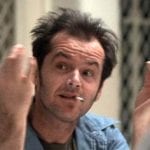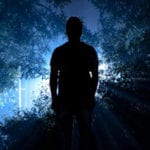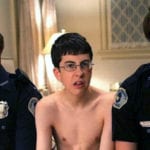 Miscellaneous
Miscellaneous  Miscellaneous
Miscellaneous  Politics
Politics 10 Lesser-Known Far-Right Groups of the 21st Century
 History
History Ten Revealing Facts about Daily Domestic Life in the Old West
 Weird Stuff
Weird Stuff 10 Everyday Products Surprisingly Made by Inmates
 Movies and TV
Movies and TV 10 Actors Dragged out of Retirement for One Key Role
 Creepy
Creepy 10 Lesser-Known Shapeshifter Legends from Around the World
 Animals
Animals 10 Amazing Animal Tales from the Ancient World
 Gaming
Gaming 10 Game Characters Everyone Hated Playing
 Books
Books 10 Famous Writers Who Were Hypocritical
 Humans
Humans 10 of the World’s Toughest Puzzles Solved in Record Time
 Miscellaneous
Miscellaneous 10 Ironic News Stories Straight out of an Alanis Morissette Song
 Politics
Politics 10 Lesser-Known Far-Right Groups of the 21st Century
 History
History Ten Revealing Facts about Daily Domestic Life in the Old West
Who's Behind Listverse?

Jamie Frater
Head Editor
Jamie founded Listverse due to an insatiable desire to share fascinating, obscure, and bizarre facts. He has been a guest speaker on numerous national radio and television stations and is a five time published author.
More About Us Weird Stuff
Weird Stuff 10 Everyday Products Surprisingly Made by Inmates
 Movies and TV
Movies and TV 10 Actors Dragged out of Retirement for One Key Role
 Creepy
Creepy 10 Lesser-Known Shapeshifter Legends from Around the World
 Animals
Animals 10 Amazing Animal Tales from the Ancient World
 Gaming
Gaming 10 Game Characters Everyone Hated Playing
 Books
Books 10 Famous Writers Who Were Hypocritical
 Humans
Humans 10 of the World’s Toughest Puzzles Solved in Record Time
10 A24 Movies That Broke the Mold
Founded by Daniel Katz, David Fenkel, and John Hodges as a film distribution company back in 2012, A24 has been something of a mission over the past decade to champion unique, quirky, and award-winning films with an independent mandate. Moving into the production game in 2016, the company has led the charge in putting out exciting films that seek to alter the status quo, defy audience expectations, and in many ways, flip the bird at the stagnant and repetitive Hollywood system, whose preoccupation with capes and spandex has stifled the kind of creative filmmaking A24 is all about.
Most of the films they put out are not just good but actively shift our expectations of cinema and what it is capable of. Thus, each of the following films takes a sledgehammer to the filmmaking mold and speaks to the true extent of A24’s input in the industry in recent years.
Related: Top 10 Incredible Movies With Ambiguous Endings
10 Eighth Grade (2019)
Bo Burnham’s coming-of-age comedy Eighth Grade may sound like a setup for your typical teen movie—awkward eighth grader transitions from middle to high school while navigating the trials of mean girls, pool parties, and social media—but it is anything but.
Subversive from beginning to end, Eighth Grade is an anti-teen movie, eschewing plots about ugly ducklings, virginity pacts, and the Spring Break party to end all Spring Break parties, to prioritize authentic relationships. Courting realism, Burnham rooted his research in the least-viewed YouTube vlogs of eighth graders, building their personalities, mannerisms, vocabularies, and expressions into his script. He also cast actual eighth graders, including star Elsie Fisher in environments that neither play up the bullies nor play down the flaws in painting a cringingly accurate portrayal of such a pivotal time of life.
But all this effort to represent the struggles of being a teen was almost wasted when the MPAA gave Eighth Grade an R rating. In response, A24 and Burnham arranged one-off free screenings in every U.S. state, bypassing the censor’s ratings to reach their target audience.[1]
9 Hereditary (2018)
A24 has played a huge part in revolutionizing, modernizing, and re-popularizing horror, helping guide and sustain a renaissance for the genre that has seen it transformed from the cheap thrills of the ’00s to the mainstream artform we know today. And one of its standard bearers comes in the unassuming form of Ari Aster, whose feature-length debut Hereditary might be the scariest popular horror of all time.
Foregoing jump scares and many other cliches and cheap tricks we associate with the genre, Hereditary builds its tension around a family of four and the many bizarre tragedies that befall them, leaving audiences guessing until late on whether there is any supernatural involvement. But the key element to the whole picture is the sound. Avant-garde composer Colin Stetson was tasked by Aster to produce a score that acted as its own character in the film, a looming evil presence that would fill the absence of a visual one. And he did—Stetson created a dark and haunting 85-minute soundscape (covering 66% of all screen time) whose primary instrument was, of all things, his own voice.[2]
8 The Lighthouse (2019)
Robert Eggers’s second feature-length film The Lighthouse was also his second film with A24, and it exemplifies the kind of risks the company is willing to take in order to bring an auteur’s vision to life. The Lighthouse is the tale of two nineteenth-century lighthouse keepers (“wickies”), played by Robert Pattinson and Willem Dafoe, who gradually lose touch with reality while marooned for months on a small island off the New England coast.
Nothing about The Lighthouse is conventional, whether this is the fact it is presented in black and white or uses the 1.19:1 Movietone aspect ratio (a square format prevalent in the 1920s). Or maybe it is that it was filmed on location in Cape Forchu, where the wind, rain and cold were as real as they look onscreen. But the over-the-top attention to authenticity doesn’t end there, as Eggers had Pattinson and Dafoe speak in often incomprehensible nineteenth-century wickie dialogue while working in very tight spaces (squeezing all scenes into a narrow aspect ratio), living in filth, and throwing up and wetting themselves on camera.[3]
7 Moonlight (2016)
The very first film produced by A24, Barry Jenkins’s Moonlight, tells the story of a young homosexual Black man, Chiron, through his childhood, adolescence, and the beginnings of adulthood, exploring the challenges associated with his sexuality and identity.
The film breaks narrative convention by having three different actors (Trevante Rhodes, Ashton Sanders, and Alex Hibbert) portray Chiron, with each section touching on pivotal moments that influence his development in the next. To achieve a distinctive visual style in keeping with the time and setting, colorist Alex Bickel also edited each chapter to emulate different film stock—Fuji, Kodak, and Agfa.
Much more than unusual narrative and visual styles, however, Moonlight presents a thoughtful intersection of Black masculinity, vulnerability, and homosexuality, the first of its kind to be recognized globally. Support for the film and its work in bringing the struggles and nuance of the gay Black community to such a large audience was so great it even won the Golden Globe for Best Motion Picture and the Academy Award for Best Film.[4]
6 Midsommar (2019)
Leading with a horrific string score/human scream match cut, Ari Aster’s sophomore feature Midsommar opens on the literal and metaphorical darkness of a double murder-suicide in winter, as protagonist Dani Ardor’s (Florence Pugh) entire immediate family is killed in one fell swoop. This inspires her to get away for a while on a trip to a remote Swedish village with her boyfriend and his college classmates, where the villagers are celebrating a midsummer festival that occurs once every 90 years.
Once Dani has left the U.S. behind, the whole film plays out in broad daylight as the mysterious Swedes’ ploy to collect nine human sacrifices becomes apparent. On paper, Midsommar shouldn’t work. Not only is daylight not scary, but there is no discernible villain; the villagers operate together and have nothing but joy and solidarity to spread among their surviving guests. Yet, in breaking the most fundamental rules of the horror playbook, the film still comes out on top. And, as if that wasn’t enough, it gambles everything on a pre-credit tapestry that spoils the entire plot.[5]
5 Uncut Gems (2019)
Known for their innovative approach to filmmaking, taking risks, and creating the space for established actors and non-actors alike to try something new, the Safdie brothers struck cinematic gold with their New York-set fifth feature, Uncut Gems. And the innovation of this street-level crime thriller is twofold, casting Adam Sandler in a serious dramatic role and generating a breakneck tension that makes the film viscerally stressful to watch.
The film sees Sandler perfectly cast against type as Howard Ratner, a jeweler and gambling addict who pushes himself, his wife, and the audience to the absolute breaking point of pure, unadulterated anxiety as he makes bad call after bad call. Using sheer will and determination, the Safdies got a nuanced performance out of Sandler quite unlike anything audiences have seen from him before. Still, their tactile visual claustrophobia took a little more technical graft. To achieve this effect, the brothers directed cinematographer Darius Khondji to break from his typically elegant style and use garish lighting, sharp angles, overcrowded compositions, and high contrast while moving from conflict to conflict in a continuous stream of terror.[6]
4 The Green Knight (2021)
In a left-field move even by A24 standards, director David Lowery chose to rejuvenate a 14th-century poem that most people without a degree in English literature have never heard of: Sir Gawain and the Green Knight. A coming-of-age tale set in Arthurian times, The Green Knight stars Dev Patel as King Arthur’s hapless, luckless, story-less nephew, who must cease his drinking and louting and go on a quest to find the mysterious Green Knight.
Casting Patel (a mixed-race actor) in a role and period that is traditionally cast all-white was a bold yet striking choice, adding to an overarching visual style that helps make such an old text relevant to a contemporary audience. Underpinned by a rich and mesmeric color palette, The Green Knight is a wonder to watch, taking the medieval setting and making it vibrant yet believable. But what went on behind the camera was equally as important, as this was the first vegan medieval fantasy film. Owing to Lowery’s veganism, the production designers made every piece of leather and clothing seen onscreen from non-animal materials.[7]
3 Men (2022)
Though best known for his 2015 sci-fi debut Ex Machina, a deep, dark musing on free will, Alex Garland brutalized screens under the A24 banner again in 2022 with the folk horror film Men. Set in a village deep in the English countryside, a grieving woman (Jesse Buckley’s Harper) escapes the city for some solitude and reflection, only to find herself stalked and victimized by a town of eerily similar and ever-more antagonistic men.
While this setup is enough to send chills to the core of any woman holidaying alone, the film’s greatest horrors stem from its unprecedented approach to casting. Rory Kinnear stars opposite Buckley as, well, everyone: He plays all the village’s occupants, including the vicar, the police, the publican, and even a young boy. Often appearing as multiple different iterations of himself in each scene, Kinnear was able to drop in and out of the different characters, having prepared for the part by composing extensive biographies, which were subsequently used by hair and makeup to help bring each man to life.[8]
2 The Tragedy of Macbeth (2021)
Few citizens of the Western world are not familiar with William Shakespeare’s Macbeth, but equally, few have conceived of it in quite the way Joel Coen did in The Tragedy of Macbeth. It was a bold decision for a director known for contemporary comedy to bring a 17th-century tragedy to the screen in black and white, with a 4:3 aspect ratio, using Shakespeare’s original language. Bolder still, perhaps, is the color- and culturally-blind casting of Denzel Washington, who plays the titular Scottish lord with an American accent.
What really makes the film different, however, is its staging, lighting, and visuals. Cinematographer Bruno Delbonnel’s famously rich color palettes (Amelie, Big Eyes) are utilized in Macbeth to make the black and white pop. But production designer Stefan Dechant had the largest hand in bringing Coen’s vision to life, building soundstage sets replete with optical illusions designed to break down the boundaries between up and down, day and night, interior and exterior. The result is fittingly a disorienting adaptation unlike any other, which leaves viewers immersed in the horrors of Shakespeare’s greatest tragedy.[9]
1 Everything Everywhere All at Once (2022)
Daniel Kwan and Daniel Scheinert’s (known as “Daniels”) genre-smashing breakthrough Everything Everywhere All at Once is the jewel in A24’s crown, as both a runaway critical success and their highest earning title at the box office. Embracing Asian-American culture and the trials faced by second-generation immigrants, the film is set in a surreal world of multiverses where characters use earpieces and trigger actions to shift into other realities, personas, and skill sets.
Everything Everywhere blends influences from across the cinematic canon, winkingly referencing everything from Crouching Tiger, Hidden Dragon (which also featured the film’s star Michelle Yeoh) with extensive martial arts sequences to the MCU with dimension-hopping antics and sci-fi visuals to Ratatouille—or should that be Raccaccoonie? Bending the public’s preoccupation with multiverses and metafiction to the absolute extreme, there are no film boundaries this picture doesn’t trample, including a fake-out ending with credits.
As if that wasn’t enough, it was all made on a budget of $25 million. And it had only a five-person effects team using old-school techniques and filmmaking tricks, such as wires, puppets, and basic green screens, to give the experience of a far more expensive production.[10]








